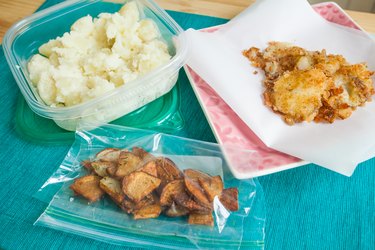
The ways in which you cook, package, store and thaw potatoes contribute to their safety and quality when you serve them, but cooling cooked potatoes in an ice-water bath before you freeze them is a vital step. Quick-cooling cooked potatoes to 40 degrees Fahrenheit or below minimizes the time the potatoes stand in the temperature danger zone -- the temperature range in which bacteria can reproduce. Do not freeze or refrigerate hot potatoes without cooling them first -- they could raise the temperature of the freezer temporarily, making the contents susceptible to contamination.
Plain Potatoes: Blanch or Boil?
Video of the Day
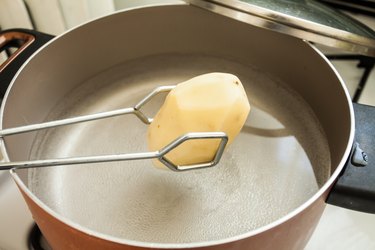
The most effective way to prepare plain potatoes without additional ingredients for freezing is to blanch them. Blanching heats the potatoes through, stopping enzyme actions in the potatoes that would result in diminished flavor, texture and coloring. But it does not fully cook the potatoes. Freezing fully cooked, boiled potatoes is possible, but they will likely fall apart when you reheat them due to the water they absorb while boiling.
Video of the Day
Freezing Blanched Potatoes
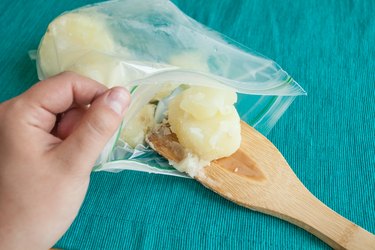
Place cut potatoes in a blanching basket, and submerge it in boiling water. Blanch potato pieces for 3 to 6 minutes, depending on their size. Transfer the potatoes to a bowl to quick-cool them in an ice-water bath. Drain them thoroughly. Transfer the potatoes to a resealable plastic freezer bag or a plastic container; leave about half-inch head space. Store the potatoes at or below 0 F up to 12 months. Place the frozen potatoes directly in boiling water to finish cooking them when you are ready to use them.
Freezing Roasted or Baked Potatoes
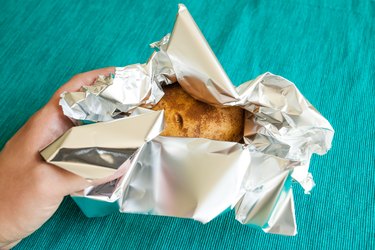
Prepare roasted, baked, stuffed or twice-baked potatoes as usual. Transfer them to a pan to quick-cool them in an ice-water bath. Package roasted potatoes in a resealable plastic freezer bag, plastic container or a disposable aluminum pan covered with foil. Wrap baked, stuffed or twice-baked potatoes individually in aluminum foil. Store potatoes at or below 0 F up to 4 weeks. Unwrap roasted or baked potatoes and transfer them directly to an oven preheated to 400 F to reheat them. Stuffed or twice-baked potatoes must reach 165 F before they are safe to eat.
Freezing Mashed Potatoes

Prepare mashed potatoes as usual. Transfer them to a bowl to quick-cool them. Store the entire batch in a freezer-safe plastic or aluminum container, or shape the potatoes into patties. Place two pieces of freezer paper between patties and stack them in freezer-safe packaging. Store mashed potatoes at or below 0 F up to 2 weeks. Thaw the potatoes just enough to remove them from plastic or freezer paper packaging, if necessary. Reheat the potatoes in an oven preheated to 350 F, stirring occasionally, or in a double boiler. Fry frozen mashed potato patties over medium-low heat, if desired. Mashed potatoes that contain any dairy product must be heated to 165 F to be safe.
Freezing Casseroles and Potatoes au Gratin
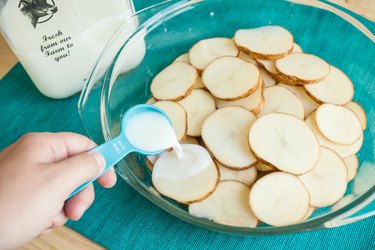
Cook potato casseroles or potatoes au gratin in a disposable aluminum pan, if possible, so you can cook and freeze the potatoes in the same pan. Reserve grated cheese or crumb toppings to add when you reheat the dish. Bake the potatoes until they are almost tender. Quick-cool the casserole or gratin in the pan. Cover it with freezer paper and aluminum foil. Store the potatoes at 0 F or below up to 2 weeks. Transfer the dish directly to an oven preheated to 400 F to reheat; cook the potatoes until they reach 165 F. Stir a little milk into the casserole to smooth an uneven sauce before the potatoes finish reheating. Add the cheese or crumb topping when the potatoes are about 150 to 155 F so it has time to brown.
Freezing Fried Potatoes
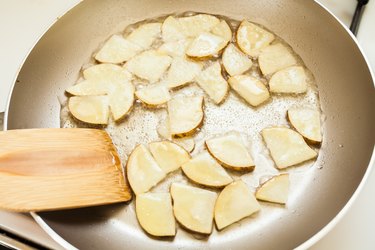
Cut, rinse and precook fried potatoes according to your recipe. Place the potatoes in hot oil as if you were frying them. Remove the potatoes from the oil when they are tender but not yet browned, after about 5 minutes. Drain them, and transfer them to a bowl to quick-cool them in an ice-water bath. Place the cool pieces in a freezer-safe bag or container. Store the fried potato pieces at or below 0 F up to 4 weeks. Transfer the frozen fries directly to hot oil to finish frying them, or place them in an oven preheated to 425 F until they are golden.
Freezing Potato Pancakes
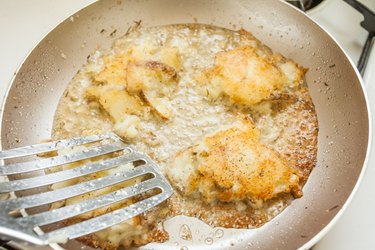
Prepare potato pancakes as usual. Transfer them to a pan to quick-cool in an ice-water bath. Stack the pancakes with two sheets of freezer paper between each pancake; store the stacks in freezer-safe packaging. Freeze potato pancakes at or below 0 F up to 2 months. Thaw the pancakes just enough to remove the freezer paper. Bake them at 400 F for 2 to 3 minutes.
- Penn State Extension: Potatoes -- Fresh and Frozen
- U.S. Department of Agriculture: Leftovers and Food Safety
- National Center for Home Food Preservation: Blanching
- National Center for Home Food Preservation: How Long Can I Store Frozen Foods
- National Center for Home Food Preservation: Freezing Prepared Foods
- National Center for Home Food Preservation: Freezing New Irish Potatoes